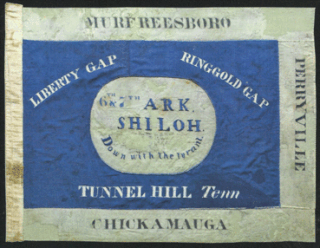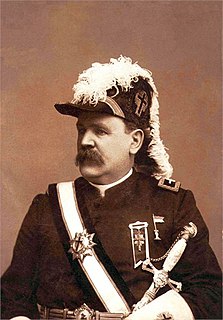William T. Simmons (29 January 1843 - 27 December 1908) was a first lieutenant in the United States Army who was awarded the Medal of Honor for gallantry at the Battle of Nashville in Tennessee during the American Civil War. [1] [2] [3] [4]
William T. Simmons (29 January 1843 - 27 December 1908) was a first lieutenant in the United States Army who was awarded the Medal of Honor for gallantry at the Battle of Nashville in Tennessee during the American Civil War. [1] [2] [3] [4]
Simmons was born in Virden, Illinois on 29 January 1843. At various points in his life he worked as a contractor, builder, carpenter, furniture dealer, and undertaker. He fathered two children. He died on 27 December 1908 and was buried in plot MH B-11 at St. Helena Public Cemetery, St. Helena, California. [1] [2] [4]
Simmons enlisted in the Army on 1 August 1861 at Springfield, Illinois as a second lieutenant and was commissioned into Company C of the 11th Missouri Infantry Regiment on the same day. In 1862, he was wounded in the right shoulder by a shell at the Siege of Corinth in Mississippi. On 16 December 1864, at the Battle of Nashville, he wounded a Confederate color bearer and captured the flag of the 34th Alabama Infantry. He was awarded the Medal of Honor for this action on 24 February 1865. [2] [4]
Simmons' Medal of Honor citation reads: [2]
The President of the United States of America, in the name of Congress, takes pleasure in presenting the Medal of Honor to First Lieutenant William Thomas Simmons, United States Army, for extraordinary heroism on 16 December 1864, while serving with Company C, 11th Missouri Infantry, in action at Nashville, Tennessee, for the capture of the flag of the 34th Alabama Infantry (C.S.A.). Being the first to enter the works, he shot and wounded the enemy color bearer.
— E. M. Stanton, Secretary of War
Simmons took a leave of absence in Washington D.C. after capturing the flag and was mustered out of the Army on 15 January 1866. [4]

The Battle of Nashville was a two-day battle in the Franklin-Nashville Campaign that represented the end of large-scale fighting west of the coastal states in the American Civil War. It was fought at Nashville, Tennessee, on December 15–16, 1864, between the Confederate Army of Tennessee under Lieutenant General John Bell Hood and the Union Army of the Cumberland under Major General George H. Thomas. In one of the largest victories achieved by the Union Army during the war, Thomas attacked and routed Hood's army, largely destroying it as an effective fighting force.

The 41st Ohio Infantry Regiment was an infantry regiment in the Union Army during the American Civil War.

The 104th Ohio Infantry Regiment, sometimes 104th Ohio Volunteer Infantry was an infantry regiment in the Union army during the American Civil War. It played a conspicuous role at the Battle of Franklin during the 1864 Franklin-Nashville Campaign, where six members later received the Medal of Honor, most for capturing enemy flags.

The 22nd Alabama Infantry Regiment was an infantry regiment that served in the Confederate Army during the American Civil War.

George VanStavoren Kelley was a line officer in the Union Army during the American Civil War. He received the Medal of Honor for gallantry at the Battle of Franklin during the 1864 Franklin-Nashville Campaign.

John Herbert Kelly was, at the time of his promotion, the youngest brigadier general in the Confederate States Army. He became one of the youngest generals to die during the American Civil War, at the age of 24. His death occurred during an engagement at Franklin, Tennessee on September 2, 1864 during Major General Joseph Wheeler's raid into Tennessee in August and early September 1864 in an attempt to destroy the railroad that Union Army Major General William Tecumseh Sherman was using to supply his force from Chattanooga, Tennessee during the Atlanta Campaign.
The 95th Ohio Infantry Regiment, sometimes the 95th Regiment, Ohio Volunteer Infantry was an infantry regiment in the Union Army during the American Civil War.
The 24th Missouri Infantry Regiment was an infantry regiment that served in the Union Army during the American Civil War.
The 13th Arkansas Infantry (1861–1865) was a Confederate Army infantry regiment during the American Civil War. Organized mainly from companies, including several prewar volunteer militia companies, raised in northeastern Arkansas, the regiment was among the first transferred to Confederate Service, and spent virtually the entire war serving in Confederate forces east of the Mississippi River. After the unit sustained heavy casualties during the Battle of Murfreesboro, the unit spent most of the rest of the war field consolidated with the 13th Arkansas Infantry Regiment, to form the 5th/13th Arkansas Infantry Regiment.

The 7th Arkansas Volunteer Infantry (1861−1865) was a Confederate Army infantry regiment during the American Civil War. Organized mainly from companies, including several prewar volunteer militia companies, raised in northeastern Arkansas, the regiment was among the first transferred to Confederate service, and spent virtually the entire war serving east of the Mississippi River. After the unit sustained heavy casualties in the Battle of Shiloh and the Kentucky Campaign, the unit spent most of the rest of the war field consolidated with the 6th Arkansas Infantry Regiment to form the 6th/7th Arkansas Infantry Regiment.

8th Arkansas Infantry Regiment was an infantry formation in the Confederate States Army during the American Civil War. It served throughout the war in the western theater, seeing action in the Kentucky, Tennessee and Georgia campaigns. Following its depletion in numbers the regiment was consolidated several times with other Arkansas regiments, finally merging in 1865 into the 1st Arkansas Consolidated Infantry Regiment.
Henry M. Hardenbergh was a veteran of the American Civil War and a recipient of the Medal of Honor.

Thomas R. Kerr was a soldier in the Union Army in the American Civil War. Kerr received his country's highest award for bravery during combat, the Medal of Honor. Kerr's medal was won for his capturing the flag of the Confederate 8th Virginia Cavalry Regiment at Moorefield in West Virginia on August 7, 1864. He was honored with the award on June 13, 1894.
The 119th Regiment, Illinois Volunteer Infantry was an infantry regiment in the Union Army during the American Civil War.

The Helena Artillery (1861–1865) was a Confederate Army artillery battery during the American Civil War. The unit was known by several other designations during the war including; Clarkson's Battery, Company A, Shoup's Artillery Battalion, Calvert's Battery and Key's Battery. The unit was occasionally assigned to artillery battalions from other states, so the Arkansas unit was at various times designated as Company C, 20th Alabama Light Artillery Battalion and later as Company H, 28th Georgia Artillery Battalion.
The 1st and 4th Missouri Infantry (Consolidated) was an infantry regiment that served in the Confederate States Army during the American Civil War. The regiment was formed on November 7, 1862 when the 1st Missouri Infantry and the 4th Missouri Infantry were consolidated as a result of heavy battle losses in both units. The regiment served in several battles in the 1863 Vicksburg campaign, including a charge that almost broke the Union line at the Battle of Champion Hill. When the Siege of Vicksburg ended with a Confederate surrender, the regiment was captured and later exchanged. In 1864, the regiment fought in the Atlanta campaign, and suffered heavy losses at the Battle of Franklin. On April 9, 1865, the regiment surrendered at the Battle of Fort Blakely, and was paroled in May when the war ended for all effective purposes.

40th Missouri Infantry Regiment was a infantry unit from Missouri that served in the Union Army during the latter part of the American Civil War. The regiment was organized in August and September 1864 to serve for 12 months. Beginning in November, the unit fought in the Franklin–Nashville Campaign. In March and April 1865, the regiment was part of the expedition that captured Mobile, Alabama. The soldiers were mustered out of Federal service in August 1865.

44th Missouri Infantry Regiment was a infantry unit from Missouri that served in the Union Army during the latter part of the American Civil War. The regiment was organized in August and September 1864 to serve for 12 months, with the tenth company only serving six months. Beginning in November, the unit fought in the Franklin–Nashville Campaign. At the Franklin on 30 November 1864, the regiment suddenly found itself in the center of an extremely bloody fight. In March and April 1865, the regiment was part of the expedition that seized Mobile, Alabama. The soldiers were mustered out of Federal service in mid-August 1865.

John Henry Ricksecker was a private in the United States Army who was awarded the Medal of Honor for gallantry during the American Civil War. On 30 November 1864, Ricksecker captured the flag of the 16th Alabama Artillery of the Confederate Army. For this action, he received the Medal of Honor on 3 February 1865.
George W. Welch was an American soldier who was awarded the Medal of Honor during the American Civil War. The medal was presented on 24 February, 1865 for actions with 11th Missouri Infantry at the Battle of Nashville on 16 December, 1864.